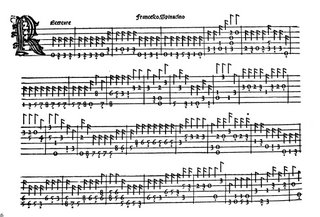
There's a nice review of the Chuckerbutties' recent Ibiza concert here in the Diario de Ibiza (in Spanish). This weekend we're taking the quartet to Palma de Mallorca.
In between, I'm enjoying some light relief practising the lute instead. Next year is the 500th anniversary of the first ever printed lute music, Francesco Spinacino's Intabulatura de Lauto, published by Petrucci in Venice in 1507. In fact it's almost the first music of any sort to be published. But, far from being tentative, it shows how highly developed lute music already was by this time, even though there's tantalisingly little earlier music in manuscript. (One happy earlier survivor is the late 15th century heart-shaped Pesaro manuscript, available in facsimile - at a price - from Amadeus Music in Switzerland.)
In 200 pages of music Spinacino presents extensive solo lute transcriptions of polyphonic vocal music, both sacred and secular, duets for two lutes, and 26 highly individual, free-form recercares. I really can't tell whether these are daringly innovative or looking back to an earlier age. They certainly sound innovative - irregular phrase lengths, fluid melodies breaking up into angular pseudo-polyphony, jaw-dropping harmonic shifts. But those same single-line fluid melodies look back to the medieval tradition of playing the lute with a plectrum (as indeed is still the case with the Arabic oud). On the renaissance lute, these melodies are played with alternating thumb and index finger on the right hand, giving a strong down-stroke and a weaker upstroke like a plectrum.
This is meticulously marked in the tablature. If you look closely (click picture to enlarge) you'll see that alternate notes are marked with a dot beneath, indicating the index finger of the right hand. This thumb and finger technique, different from the classical guitar technique of playing melodies with alternating index and middle fingers, remained in use throughout the sixteenth century, its speed making possible the 'divisions' which were such a feature of renaissance lute writing.
The first line of this Recercare has a wonderful, wrenching harmonic shift, typical Spinacino. The improvisatory opening seems to be settling nicely into E flat major. Until the first cadential chord comes in bar 5, and it's not E flat at all, but an assertive, unambiguous D minor, miles away. A shock which sets a suitably unsettled mood for the rest of the piece. I must do a transcription into staff notation to show this more clearly.
Spinacino's one-page guide at the beginning of the book, in Latin and Italian, gets as far as explaining how to write quintuplets. Unexpected.
'Spinacino' is also a cut of veal. Here's a recipe.

2 comments:
Fearnley wrote: Hi Peter, sounds like you are settling down to a well-deserved spell of "je lute avec mon lute"...it would be wonderful if you were able to post a bit of this daring piece actually being played!
You should move your blog to http://livejournal.com
Lots more readers, and a large contingent of lute aficionados.
RT
Post a Comment